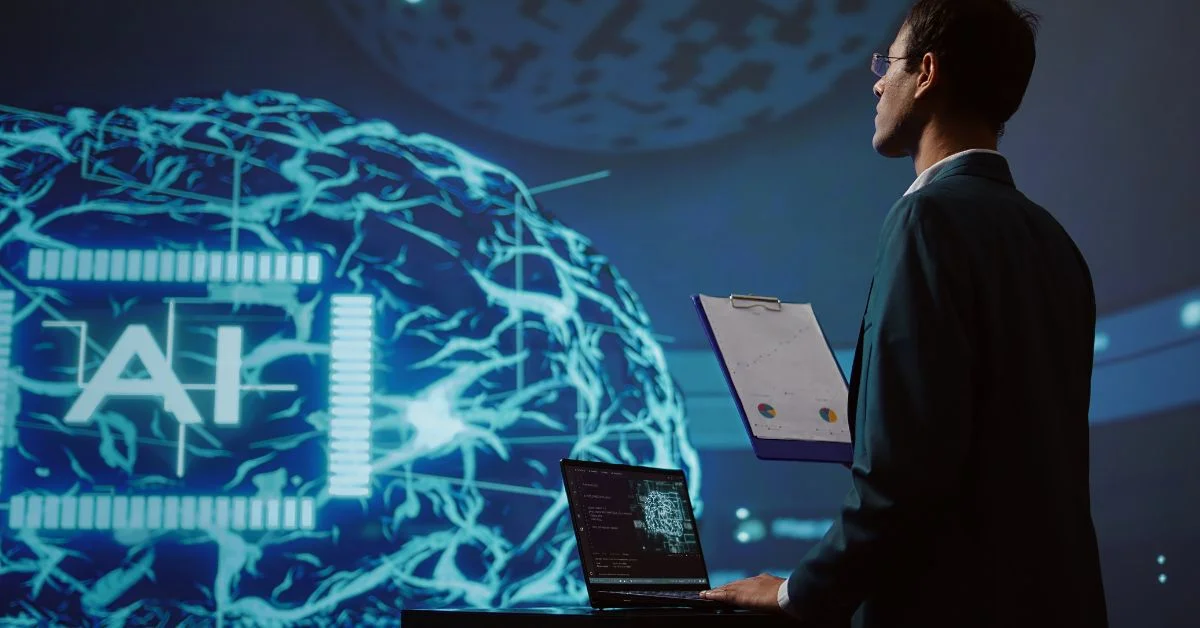Artificial intelligence (AI) isn’t just a buzzword; it’s a transformation. Companies, universities, and governments are using AI to tackle real-world problems. At the center of this revolution is Intel. Let’s explore how Intel is powering the future with AI, from chips in data centers to smart farms, edge devices, robotics, and beyond.
Leading-edge AI chips: Powering data centers and PCs
1. Xeon 6: Brain of the data center
- In June 2024 at Computex Taiwan, Intel introduced its Xeon 6 processors, which use both performance and efficiency cores to boost AI workloads. They bring up to 4.2× better performance per rack and 2.6× improved power efficiency, ideal for large-scale AI tasks.
- By May 2025, one Xeon 6 chip was chosen to serve as the host CPU in Nvidia’s DGX B300 AI system—a mark of trust in Intel as a partner in NVIDIA-designed AI infrastructure.
2. Diamond Rapids & future 18A tech
For 2026, Intel plans to launch the Diamond Rapids Xeon, built on Intel’s advanced 18A node. Offering up to 192 performance cores per socket, support for PCIe 6.0, CXL 3, DDR5-12800 memory, and AI formats like FP8 and TF32, it’s tailor-made for AI inference on a massive scale.
3. Core Ultra Series: AI PCs for everyone
On the consumer side, Intel’s new Core Ultra 200 series (U/H/V) chips were unveiled at CES 2025. They combine CPU, GPU, and built-in Neural Processing Unit (NPU) to run AI tasks right on your laptop, whether drafting emails, editing videos, or enhancing gaming visuals, with faster performance and better battery life.
Edge and sustainability: AI beyond the cloud
1. AI on the farm
At Ohio State University’s research farm, Intel-powered AI uses drones, sensors, and private 5G to spray herbicides and water only where needed. With Intel Xeon servers analyzing real-time data and laptops running Core Ultra chips, pesticide use dropped by 75%, earning cleaner water and healthier crops.
2. AI in laptops: smarter, aware, secure
In collaboration with Elliptic Labs, Intel embeds “virtual smart sensors” into its laptops. These chips help devices sense user presence, automatically switch focus, or share notifications without draining battery life and without using cameras.
Developer tools: OpenVINO, AMX & oneAPI
1. OpenVINO
Intel’s OpenVINO toolkit (latest version 2025.2, released June 2025) lets developers deploy neural networks across Intel CPUs, NPU, and accelerators with cleaner, faster code and better power usage.
2. Advanced Matrix Extensions (AMX)
Intel’s AMX is a set of x86 instructions that speed up matrix math, critical for AI. Introduced with Sapphire Rapids and expanded in Granite Rapids, AMX makes AI operations much faster on Intel Xeon chips.
3. oneAPI
Aiming to simplify coding across CPUs, GPUs, and AI chips, oneAPI gives developers a unified programming model. Developers write once, deploy on many devices, and have no need for separate CUDA or ROCm code.
Specialized AI systems: neuromorphic and quality-control tools
1. Loihi & Hala Point: neuromorphic computing
- Intel’s groundbreaking Loihi neuromorphic chips mimic how the brain works. Loihi 2 chips are used in massive systems like Hala Point, which packs over 1.1 billion artificial neurons and achieves speeds 20× faster than standard CPUs/GPUs, with huge energy savings.
- This innovation could open new frontiers in low-power AI, robotics, pattern recognition, and more.
2. CGVQM: visual quality AI
Intel developed CGVQM, a tool that uses AI to measure real-time image quality. Originally used in gaming to spot flicker or ghosting, it’s a CNN-based system comparing video frames for visual fidelity—helping developers create sharper graphics.
Strategic shifts & manufacturing focus
1. Restructuring toward AI
Under CEO Lip-Bu Tan, Intel is shrinking non-core staff and refocusing toward AI chips, edge hardware, and foundry services. They’ve launched RealSense, their AI robotics arm, investing $50 million to scale robotic and biometric devices.
2. Foundry rebuild: 18A & industry partners
- Intel is rebuilding its foundries using the 18A process. Industry players like Nvidia, AMD, and Broadcom are evaluating Intel’s tech for making AI chips.
- Once overshadowed by TSMC, Intel Foundry aims to reclaim leadership in semiconductor production.
Real-world benefits for users and businesses
Here’s a quick roundup of how these innovations help everyday users and companies:
- Faster AI on laptops for drafting emails, edits, streaming, and even offline.
- Eco-friendly agriculture saves water and chemicals.
- Powerful data center AI that balances performance and energy efficiency.
- Future neuromorphic AI with brain-like power efficiency.
- Developer-friendly tools make code simpler and more portable.
- Advanced graphics tools for better game experiences.
- Manufacturing resurgence supports local chip production.
Challenges: layoffs and competition
- Intel has faced major layoffs, cutting thousands of jobs in California, Oregon, Texas, and Israel, as it shifts resources toward AI and foundry operations.
- Competition is fierce. Nvidia leads in AI training, AMD offers strong Xeon alternatives, and bespoke AI chips from tech giants are crowding the space. Intel admits it’s late in the high-end training race, now focusing on edge and inference instead.
What comes next?
- Diamond Rapids Xeon (2026): With massive core counts and performance.
- Continued fab growth: Renewed foundry services thanks to strategic partnerships.
- Software support: OneAPI, OpenVINO, and ecosystem tools are improving over time.
- Neuromorphic evolution: Loihi-powered systems becoming more accessible in research.
- RealSense robotics: AI-driven automation gaining mainstream foothold.
Why does this matter to you
- You’re using AI apps? Intel hardware might soon make them faster, more reliable, and usable without draining your battery.
- Developers? OneAPI and OpenVINO make building AI systems simpler and more powerful.
- Companies? Intel’s edge-to-cloud solutions are lowering costs and supporting local innovation.
- Society? Better precision farming, smarter sensors, and sustainable computing are real-world benefits.
How Intel Is Powering the Future with AI is more than a headline; it’s happening now. Through chips, software, manufacturing, and applications, Intel is shaping how we live, work, and learn and helping communities and industries worldwide benefit from smarter, greener, and more accessible AI.
Conclusion: Intel’s AI journey in simple terms
Intel is working on three big fronts:
- Make AI chips smarter for servers and PCs.
- Boosting edge use, from farms to laptops.
- Simplifying developer tools to help AI run anywhere.
Yes, Intel faces tough rivals and internal shifts. But its integrated hardware-software-application approach, including chips, toolkits, and real-world solutions, is positioning it as a major force in everyday AI. Whether you’re a gamer, farmer, student, or AI engineer, Intel’s work helps bring powerful, efficient AI into your life right now.



